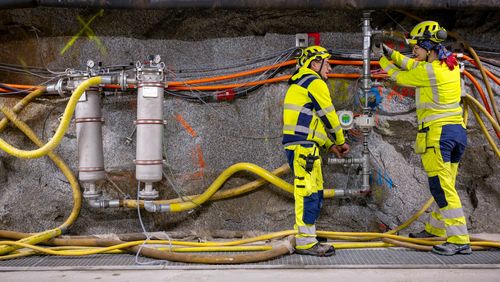
Deep geothermal energy research in the Alps
If we could harness the heat in the earth’s interior, we would have a sustainable way of producing unlimited amounts of energy. In Switzerland, however, previous attempts to drill deep for geothermal energy triggered earthquakes. Now, the new Bedretto Underground Lab in the Swiss Alps has been set up with funding from the Werner Siemens Foundation. The lab offers researchers from all over the world the opportunity to test deep geothermal energy technologies in near-authentic conditions.
Simply converting the disused railway tunnel in the Saint-Gotthard Massif into an underground research facility delivered major insights into how deep geothermal energy can be accessed safely. And when the first experiments were conducted in the Bedretto Underground Lab, so many research groups from Switzerland and abroad showed interest that a veritable traffic jam developed. To increase capacity, a second underground lab has been under construction since 2022 – also with generous support from the Werner Siemens Foundation.
In principle, deep geothermal energy production is fairly simple: first, two holes are drilled deep into the earth’s crust where the rock is hot – at a depth of five kilometres, temperatures range between 150 and 200 degrees Celsius. Then, in a second step, water is pumped into the first borehole, where it begins seeping through fine cracks in the rock until it reaches the second borehole. On its way, the water gets so hot that it exits the hole in the form of steam. This steam is then channelled into a turbine and used to produce electricity. A major drawback, however, is that hard rock like granite is nearly impermeable by nature, which is why geologists provide some outside assistance: they apply extreme pressure to fracture the rock. This procedure requires painstaking care, as it can otherwise trigger earthquakes, as happened fifteen years ago in Basel.
In their current work, the researchers in the Bedretto Underground Lab are seeking the best way to generate fissures in the granite. A promising procedure has already been tested: a multi-step stimulation in which fissures are provoked section by section, staggered over time. This project, called “Destress”, was carried out in 2021. “It’s a major breakthrough for deep geothermal energy research,” says Marian Hertrich, geophysicist at ETH Zurich and manager of the Bedretto Underground Lab.
The researchers in the team led by project initiator Domenico Giardini are also testing an alternative method of energy storage in heat reservoirs. Rather than drilling down 5000 metres to produce electricity immediately, they want to determine whether a moderate depth of 1500 metres would be sufficient for heating the water during the summer months when electricity is available in great supply. During the cold winter months, power could then be generated from the heat stored in the reservoirs. Heat reservoirs have two major advantages over deep geothermal energy production. First, dangerous earthquakes are much less likely to be triggered at more moderate depths. Second, costs are lower – partly due to savings on infrastructure expenses, but also because the electric power needed to pump the water through the rock layers is practically free in summer.
Facts and figures
Project
In the Bedretto Underground Lab, international research groups are conducting closely monitored experiments in nearauthentic conditions to determine whether geothermal energy can be safely harnessed. They want to better understand how deep rock layers react to drilling and stimulation treatments and find ways to better predict earthquakes.
Support
The Werner Siemens Foundation is supporting the further development of the Bedretto Underground Lab as well as the MISS flagship project (Mitigating induced seismicity for successful georesources applications) in which researchers seek ways to minimise the effects of induced earth tremors and thus create the conditions to safely use deep geothermal technologies.
Financing institutions
ERC 2019 Synergy Grant of the European Research Council; EU Framework Programme for Research: Horizon 2020; multinational EU joint project: GEOTHERMICA; ETH Zurich; Werner Siemens Foundation; Swiss National Science Foundation; Federal Office of Energy, Switzerland; Innosuisse – Swiss Innovation Agency
Tunnel proprietor
Matterhorn-Gotthard Railway
Building commission
ETH Zurich; Swisscom
Funding from the Werner Siemens Foundation
12 million Swiss francs
Project duration
2018 to 2024
Project leader
Prof. Dr Domenico Giardini, Professor of Seismology and Geodynamics, ETH Zurich
Research partners
ZoDrEx; DESTRESS – Demonstration of soft stimulation treatments of geothermal reservoirs; Swiss Competence Center for Energy Research – Supply of Electricity; Validation of Technologies for Reservoir Engineering (VTRE); Swiss Seismological Service (SED), ETH Zurich; ETH Zurich; EPFL; University of Lausanne; University of Neuchâtel; Anger; Cetim; CSIC; IDAEA; És-Géothermie; Geo-Energie Suisse AG; GZB; Rhein-Westphalian Technical University Aachen (RWTH); Sirius E.S. GmbH; Welltec
Safety
Suva; SiBau Management GmbH; Swiss Seismological Service (SED), ETH Zurich
Construction
Baumeler Leitungsbau AG; Fretus AG; Azienda elettrica comunale Bedretto; awa PlanBau GmbH; Cava di estrazione di ghiaia di Bedretto
Lab operator
ETH Zurich; Department of Earth Sciences, ETH Zurich
Lab sponsors
ETH Zurich; Werner Siemens Foundation






